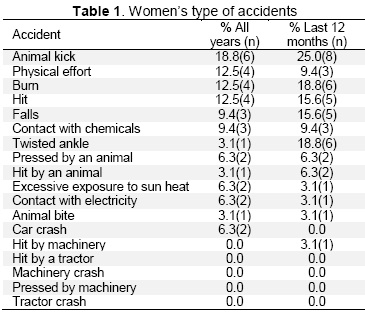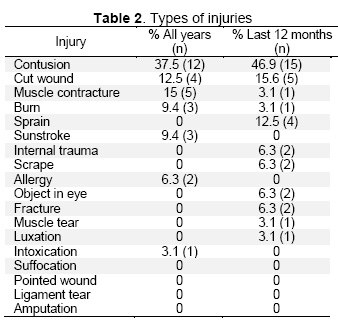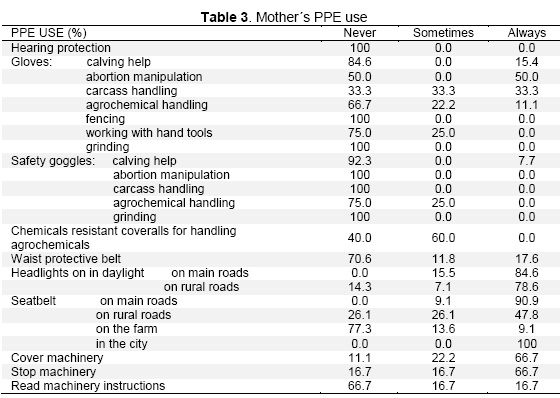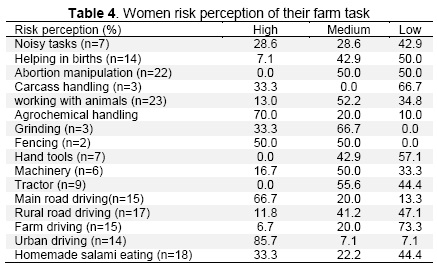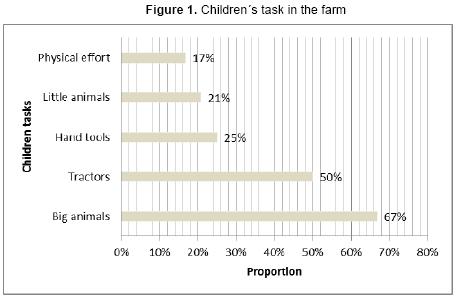Services on Demand
Journal
Article
Indicators
-
 Cited by SciELO
Cited by SciELO -
 Access statistics
Access statistics
Related links
-
 Cited by Google
Cited by Google -
 Similars in
SciELO
Similars in
SciELO -
 Similars in Google
Similars in Google
Share
Revista de Salud Pública
Print version ISSN 0124-0064
Rev. salud pública vol.17 no.1 Bogotá Jan./June 2015
https://doi.org/10.15446/rsap.v17n1.40090
http://dx.doi.org/10.15446/rsap.v17n1.40090
Artículo/Investigación
Hazards for Women and Children in Rural Settings
Peligros para las mujeres y niños en el ámbito rural
Ana I. Molineri1, Marcelo L. Signorini-Porchietto2 y Héctor D. Tarabla3
1 Universidad Nacional del Litoral. Santa Fe, Argentina. amolineri@fcv.unl.edu.ar; amolineri@hotmail.com
2 Consejo Nacional de Investigaciones Científicas y Técnicas. Departamento de Instituto Nacional de Tecnología Agropecuaria EEA. Santa Fe Argentina. marcelo.signorini@gmail.com
3 Instituto Nacional de Tecnología Agropecuaria EEA Rafaela. Facultad de Ciencias Veterinarias Universidad Nacional del Litoral. Santa Fe, Argentina. tarabla.hector@inta.gob.ar
Received 3 October 2013/Sent for Modification 12 January 2014/Accepted 5 March 2015
ABSTRACT
Objectives a) To identify possible risk factors associated with rural accidents in women, b) to describe women's knowledge about zoonosis, c) to describe women's risk perception about farming, d) to describe mother´s risk perception about children's activities in rural settings, e) to estimate the initial age of exposure to the rural setting and its dangers, and f) to identify possible risk factors associated with rural accidents in children.
Materials and Methods: Cross-sectional design. Women with children that live in the countryside were surveyed (n=24). Structured questionnaire. Statistical analyses: χ2, Student's t-test, Pearson's correlation coefficient and logistic regression.
Results Many women had suffered an accident in the countryside (65.6 %). Farm worker usually did not use personal protective equipment (PPE). Hearing protection, gloves, and safety goggles were rarely used. Working women showed a high risk perception for urban driving, the handling of agrochemicals, and driving on main roads (85.7 %, 70 % and 66.7 %). There was no significant association between risk perception and PPE use. Most mothers (87.5 %) thought that was good for children to learn how to perform farm chores starting at a young age. Children started to drive a tractors at 9 years of age; 12.23 years on average. More than 7 % of the children (7.14 %) have suffered an accident on the farm. The most frequent accidents were being trapped in machinery (60 %). No association was found between the independent variables and the dependent variable; farm-related accidents in children (p>0.2).
Conclusions Risk communication is necessary to inform people involved and to reduce exposure.
Key Words: Accident, child, risk perception, women (source: MeSH, NLM).
RESUMEN
Objetivos a) identificar posibles factores de riesgo asociados a accidentes rurales en mujeres, b) describir el conocimiento sobre zoonosis de las mujeres, c) describir la percepción de riesgos de las mujeres acerca de las actividades realizadas en el campo, d) describir la percepción de riesgos de las madres sobre las actividades de los niños en el campo, e) estimar la edad de exposición inicial de los niños al ambiente rural y sus peligros y f) identificar potenciales factores de riesgo asociados a accidentes rurales en niños.
Materiales y Métodos Diseño transversal. Fueron encuestadas las mujeres con hijos que vivían en el campo (n= 24). Cuestionario estructurado. Análisis estadístico: χ2, T Student, coeficiente de correlación de Pearson y Regresión Logística.
Resultados Muchas de las mujeres sufrieron un accidente en el campo (65,6 %). Las trabajadoras rurales generalmente no usaban elementos de protección personal (EPP). Protección auditiva, guantes y antiparras eran escasamente utilizados. Las trabajadoras demostraron tener una percepción del riesgo alta sobre el manejo de vehículos en zonas urbanas, manipulación de agroquímicos y manejo de vehículos en rutas (85,7 %, 70 % y 66,7 %). No se encontró asociación significativa entre percepción de riesgos y uso de EPP. Muchas madres (87,5 %) pensaban que era bueno para los niños que aprendieran a realizar tareas del campo desde muy pequeños. Los niños comenzaban a manejar un tractor desde los 9 años, 12,23 años en promedio. Más del 7% de los niños (7,14 %) sufrieron un accidente en el campo. Los más frecuentes fueron atrapamiento por maquinaria (60 %). No se encontró asociación significativa entre las variables independientes y la variable dependiente accidente en un niño (p>0,2).
Conclusiones Es necesaria la comunicación de los riesgos para informar a los involucrados y reducir la exposición.
Palabras Clave: Accidente, niño, percepción de riesgos, mujer (fuente: DeCS, BIREME).
The proximity between home and workplace existing on farms exposes family members to hazards that may not be present in other households (1). Resulting injuries can lead to serious disability and even death (2). Moreover, this closeness makes hazardous exposures nearly unavoidable, even for children who are not directly involved in farming tasks (3).
The farm environment is unique for children, not only because it is their parent´s workplace but also because it is their home and playground. Although children's exposure to risks is high, parents' attention is often reduced because they are working. Risk exposure for children is further increased by their participation in chores involving animals and machinery. Children on farms can be required to perform tasks for which they are not yet prepared (4).
The potential risks of a farm include agricultural machinery, livestock, chemicals and zoonosis. Farms also have a higher potential risk of injuries (5). Injuries are not distributed randomly among populations at risk. Positive associations between one's prior injuries and risk of subsequent injury have been observed. It seems that some families suffer more accidents than others (3).
Individual people are mainly responsible for handling their own health risks, since many risks are characterized as behavioral in origin and, therefore, largely under individual control (6). Nevertheless, these risks are perceived differently by society. Risk does not mean the same for all groups of people and must be addressed in a social, cultural and economic context (7, 8).
Argentinian farmers have a low perception of the risks involving professional illnesses, being totally focussed on labor accidents. Awareness of zoonoses among rural housewives is scarce and differs from the knowledge shown by urban housewives (9).
The objectives of this study were: a) to identify possible risk factors associated to rural accidents in women, b) to describe women's knowledge about zoonoses (species and means of transmission), c) to describe women's risk perception about farming, d) to describe mother's risk perception about children's rural activities, e) to estimate the initial age of exposure to rural environmental risks for children in farming and f) to identify possible risk factors associated with rural accidents in children.
MATERIALS AND METHODS
An observational study was conducted between March and April 2012 in the rural area of Egusquiza, Santa Fe Province, Argentina (31° 5′ 42″ S, 61° 37′ 37″ W). The study design was cross-sectional, the unit of interest were the women who lived on a farm and their children. The target population: women that raised their children in the rural environment of Central Santa Fe Province and children who grow up there.
Population data was obtained from Egusquiza County. From a total of 125 households, 41 lived in the rural environment. In two of the households women refused to answer the questionnaire and in another three there no one was present on three visits. Women lived in thirty-two of the remaining households and could complete a structured questionnaire during a personal interview. The questionnaire was divided into two sections: one to gather women'´s data (demographic characteristics, farming accidents, personal protective equipment use, risk perception of farm chores and zoonoses knowledge) and the other section was to gather children's data (farming chores, mother's risk perception about their children's labor in the farm and accidents until the age of sixteen). Accidents data was recorded for the last 12 months and all years under exposure in both cases (women and children).
For the purpose of this study "housewives" were defined as those women who work only at home, and "farm worker" were those who also work on the farm. There were 32 respondents, 23 of them had children.
Risk perception was defined as "the notion of the probability of a subsequent adverse health event" (6). This probability was measured according to an ordinal scale (high/medium/low) (10).
Personal protective equipment (PPE) use was quantified with an ordinal scale (never/ sometimes/ always) in accordance with Tarabla (10).
The purpose and importance of the study was explained prior to the interview, emphasizing that responses would be anonymous, since the interest was not the experience of any particular respondent but the frequency of events at the population level. All interviews were performed by the senior author.
Statistical analyses included χ2 (Chi), Student's t-test and Pearson's correlation coefficient. All statistical analysis was performed using InfoStat® program (Universidad Nacional de Córdoba, Argentina).
Ethics approval
This study was approved by the safety and ethics committee of the Facultad de Ciencias Veterinarias, Universidad Nacional del Litoral. Protocol n°: 160/2013. Exp.: 15817.
RESULTS
-Women demographic characteristics
On average, the respondents were 37.4 years old (between 18 and 79). Most of the respondents were legally married (65.6 %) or were living with their partner (15.6 %). Most women had at least one child (71.9 %, N= 23) (12.5 % had 5 children; 20.8 % had 4; 37.5 % had 3 and 12.5 % had 1 or 2). In total, data from 70 children was gathered from 23 mothers.
Twenty-one percent were housewives (21.9 %, n= 7) and 78.1 % (n= 25) were also farm workers.
-Women´s accidents
Many women had suffered an accident on the farm (65.6 %). The most frequent accident was being kicked by an animal (last 12 months= 25 %, all years of exposure= 18.8 %), followed by burns and being bumped or cut by an object (Table 1). The most common lesions were contusion (last 12 months= 46.9 %, all years of exposure=37.5 %), cut wounds and muscle contractures (Table 2). Hands were the body part most commonly affected (last 12 months= 18.8 %, all years of exposure= 21.9 %), followed by legs and knees.
No significant association was found between having an accident and age (p=0.45). Farm workers had suffered more accidents in the last 12 months than housewives (60 % and 28.6 %, respectively, p= 0.084). Similar results were obtained when all years of exposure were taken into account (56 % and 14.3 % respectively, p= 0.040).
-Women PPE use
Farm workers usually did not use personal protective equipment (PPE). Hearing protection, gloves and safety goggles were rarely used (Table 3). Seatbelts were used more frequently in the city and main roads. The same thing was observed with headlights, they were used in daylight by 84.6 % of the women driving on main roads.
-Women's risk perception
Worker women showed high risk perception for urban driving, agrochemical handling and driving on main roads (85.7 %, 70 % and 66.7 %) (Table 4). There was no significant association between risk perception and PPE use.
-Children's chores
Most respondents (66.7 %) said that children helped in farm tasks (handling big animals= 66.7 %, driving tractors= 50 %, hand tools usage= 25 %, tasks that involved pets= 20.8 %, and physical effort= 16.7 %) (Figure 1).
On average children started to drive a tractor when they were 12.2 years old (minimum= 9, maximum= 18). The task that they started to do earliest was working with animals (since 4 years old with an average of 9.7). Work with hand tools started at 10 years old with an average of 13.2. The maximum age to start a chore was 18 years old.
-Mother´s risk perception about children's rural activities
Most mothers (87.5 %) thought it was good for children to learn how to perform farm chores starting at a young age. Risk perception was different depending on the chore involved. Many women thought that farm chores were not risky at all (60 %). Considering the 40 % of women who assumed some level of risk, 57.1 % believed that making or repairing a wire fence was the lowest risk task that a child could do, followed by work with animals (46.7 %). The tasks with the highest perceived risk were handling chemicals and pesticides (100 %), brucellosis vaccination (100 %), grain or hay grinding (87.5 %), tractors and machinery driving (76.9 % y 73.3 % respectively), noisy work (71.4 %), abortion and carcass handling (66.7 % and 62.5 % respectively). Work with hand and power tools was considered as high risk by 46.7 % of the respondents, somewhat risky by 20 % and low risk by 33.3 %. The same proportion of mothers considered helping with calving a high or low risk activity (42.9 % each) and the remaining 14.2 % considered it a task with medium risk. Risk perception with regard to their children's labor on the farm were highly correlated (r> 0.75).
-Children's accidents
More than 7 % of the children (7.1 %) have suffered an accident on the farm. The most frequent accident was being trapped by machinery (60 %, n=3). The machinery involved was a grain crusher and a disc plow. Some injuries were mild (lower extremities contusion). Only one of those accidents caused a severe injury (finger amputation). Other kinds of accidents suffered by children were being knocked or cut by an object (20 %, n=1) and being knocked by an animal (20 %, n=1). All the reported accidents occurred in the last 12 months.
No association was found between the independent variables —number of children, mother's formal education level, tasks that mothers did daily, and accidents in mothers or children while helping inn farm tasks— and the dependent variable of children's accident on the farm in the last 12 months or before (p>0.2). Neither was their a significant association between work accidents in fathers and children's accidents, or between a child's accident and age at which the child started helping with farm tasks (p>0.2). For that reason, a logistic regression model could not be performed.
DISCUSSION
This study was based on a small population of families who lived and worked on livestock farms. Asking women about their children's accidents was sustained in studies made in others countries, where it was proved that they are better interlocutors of their children's accidents than doctors or fathers (11). Results cannot be extrapolated from this small population to the total population who live and work in farms in our country, but at least this is the first study about the subject in Argentina.
Most women had suffered accidents on the farm, but the case of housewives is remarkable. They had suffered accidents on the farm just because of proximity to hazards. They were not involved directly in farm work but they got hurt just because of the exposure to risks (3).
Women's risk perception of farm work was high in many tasks but it did not make them try to protect themselves or their children. PPE use among working women was very low and it seems to be that knowledge of farm hazards was not related to the safety precautions they took to protect themselves (12).
The proportion of children who helped in farm tasks was large. This leads children to be exposed to risks since they are very young, even by standing near the adults who are working (4).
Tevis (13) conducted a study in USA to determinate at what age children start to do some tasks on farms. On average, by five years of age children fed pets and chickens and collected eggs. By the age of seven boys and girls already fed horses. Children were around cows since they were eight. Some of the parents said their children drove all terrain vehicles since they were 9. Tractors were driven by boys and girls between 10 and 11 years old. In our study the ages at which children started to do farm chores were not so different on average. Children start driving tractors and doing chores involving large animals at an older age. Some mothers said their children started to help in farm chores when they were 18. This could be because parents made them finish their studies before starting to work or because of memory bias. In Argentina law n° 26390 establishes that children can work when they are 16 years old. The problem is that farm work is usually considered a game or like any other task that children do to help their parents. This leads to them starting to do farm chores before they are ready to do it. Many times they are simple observers of the chores, but this exposes them to risks (3).
Mothers' risk perception about their children doing adult tasks was low. Furthermore, there were contradictions between mother's risk perception about certain chores and the age children started to make them. As Zentner et al. (12) said: "perception of risks did not necessarily translate into safety actions". An example of this is tractor driving, which was considered as high risk by most of the mothers, and children started doing it from the age of 12. There is also a misinterpretation of certain zoonosis exposures like brucellosis. Mothers understood that brucellosis vaccination was a high- risk task because it is a live vaccine and their children could get the illness through an erroneous manipulation of it. They considered calving assistance as a less risky task, even though this is a very important source of brucellosis and other zoonosis. This could represent an ignorance of the means of transmission of the illness or it could be because of a "free of Brucellosis" status for the farm leading them to think there is no more problem with it.
In our study mothers' risk perception were highly correlated. This has not occurred in other national studies made among rural veterinarians and workers where correlations were low (14,15).
Children's accidents were not significantly associated with any of the independent variables under study, not even with fathers' farm accidents like others researchers found (3). Maybe this is caused by the low number of accidents found among children in this study. This could be a reflection of reality or could be caused by mothers' memory bias like we said before.
There is no correspondence between mothers' risk perception about their children working on farms and the age they started letting children participate in farm chores. Children must be safe in their homes and we must protect them from accidents that are totally avoidable. Also risk communication is necessary to inform the women involved and to reduce exposure. It is very important to continue this line of investigation, perhaps with a larger number of families or in other locations to know the real situation in Argentina.
Conflict Of Interest: None
Funding: This work was supported by a CAIDO Project financed by Universidad Nacional del Litoral, Santa Fe, Argentina and PICT nº 10-0989 Project financed by Agencia Nacional de Promoción Científica (Argentina).
REFERENCES
1. Reed DB, Browning SR, Westneat SC, Kidd PS. Personal protective equipment use and safety behaviors among farm adolescents: gender differences and predictors of work practices. J Rur Health. 2006; 22 (4): 314-320. [ Links ]
2. Akdur O, Ozkan S, Durukan P, Avsarogullari L, Koyuncu M, Ikizceli I. Machine-related injuries in farm industry. An Agric Environ Med. 2010; 17, 59-63. [ Links ]
3. Ferguson CK, Langner D, Alexander BH, Gurney JG, Gerberich SG, Ryan AD, Renier CM, Mongin SJ. The association between parent´s past agricultural injuries and their children´s risk of injury. Analyses from the Regional Rural study-II. Arch Pediatr Adolesc Med. 2006; 160: 1137-1142. [ Links ]
4. Morrongielo BA, Marlenga B, Berg R, Linneman J, Pickett W. A new approach to understanding pediatric farm injuries. Soc Sci Med. 2007; 65: 1364-1371. [ Links ]
5. Larson BM, Gerberich SG, Masten AS, Alexander BH, Gurney JG, Church TR, Ryan AD and Renier C. Parents´ safety beliefs and childhood agricultural injuries. Am J Ind Med. 2009; 52: 724-733. [ Links ]
6. WHO. The world health report, World Health Organization. Reducing risks, promoting healthy life. Chapter 3. Perceiving risks. 2002, pp. 27-45. [ Links ]
7. Gifford S. The meaning of lumps: a case study of the ambiguities of risk. In: Stall R.; Janes C. & Gifford S. Eds. Anthropology and epidemiology. Interdisciplinary approaches to the study of health and disease. Dordrecht: Reidel Publications. 1986; pp 213-246. [ Links ]
8. NRC National Research Council, Committee on Risk Characterisation. Stern PC & Fineberg HV, Eds. Understanding risk. Informing decisions in a democratic society. National Academy Press; Washington (DC) (1996). [ Links ]
9. Tarabla HD, Fernández. Conocimiento sobre zoonosis en amas de casa del ámbito urbano de la ciudad de Coronda, Santa Fe. Rev FAVE- Cs Vet. 2009; 8 (1): 11-14. [ Links ]
10. Tarabla, HD. Riesgos de trabajo en Veterinaria en el Centro-Oeste Santafesino. 5ºJorn. Internac. Vet. Práctica, Mar del Plata, Buenos Aires (2007). [ Links ]
11. Erkal S, Goodwin Gerberich S, Ryan AD, Renier CM, Alexander BH. Animal-related injuries: A population-based study of a five state region in the upper midwest: Regional rural study II. J Saf Res. 2008; 39: 351-363. [ Links ]
12. Zentner J, Berg RL, Pickett W, Marlenga B. Do parent´s perceptions of risks protect children engaged in farm work? Prev Med. 2005; 40: 860-866. [ Links ]
13. Tevis C. Downsizing farm chores. Successful farming. 1994; 92 (2): 48-50. [ Links ]
14. Tarabla H, Warnke O, Marín M. Accidentes en trabajadores ganaderos en Sarmiento, Santa Fe, Argentina. Rev. Salud Pública UNC, Ed. Especial. 2009; 5: 15. [ Links ]
15. Molineri AI, Signorini ML, Pérez L, Tarabla HD. Zoonoses in rural veterinarians in the central area of Argentina. Aust J Rur Health. (2013) 21 (5): 285-290. [ Links ]













